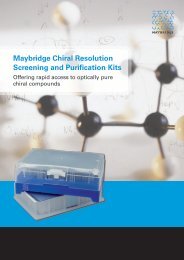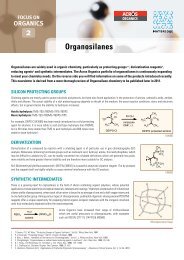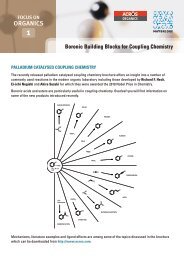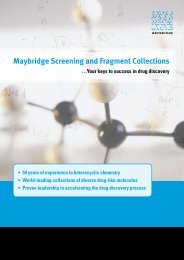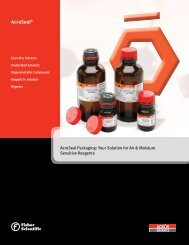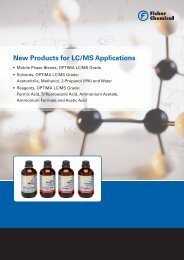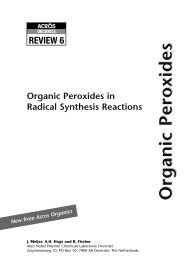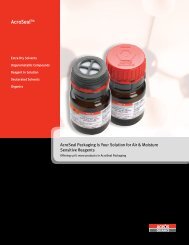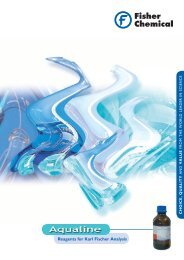Fisher Chemical
Fisher Chemical
Fisher Chemical
- No tags were found...
You also want an ePaper? Increase the reach of your titles
YUMPU automatically turns print PDFs into web optimized ePapers that Google loves.
Molecular Biology | Enzymes (Modifying)Enzymes (Modifying) | Molecular BiologyrDNase I (RNase-free)Source: Recombinant E. Coli StainOPTIZYMERibonuclease InhibitorSource: RecombinantOPTIZYME OPTIZYME T3 RNA PolymeraseSource: Recombinant E. Coli StrainOPTIZYME T4 DNA PolymeraseSource: Recombinant E. Coli StrainpackagingMfr. No1000 units PolyTube BP3226-12000 units PolyTube BP3226-2packagingMfr. No2500 units PolyTube BP3222-110000 units PolyTube BP3222-5packagingMfr. No1000 units Poly Tube BP8101-15000 units Poly Tube BP8101-5packagingMfr. No100 units Poly Tube BP8105-1500 units Poly Tube BP8105-5Tested forRNase activity, protease activity, and specific performance tests.Applications: Robust ability to remove genomic and template DNA from RNApreparations; meets or exceeds the performance of native bovine DNase I.Developed by recombinant methods; non-animal source (yeast) eliminatespotential RNase contamination-safest choice to address environmentalconcerns.Certified RNase free. Highly purified for excellent lot-to-lot consistency andoptimal performance. Can even be used inthe characterization of DNA:Protein interactions.Ideal for use in RT-PCR, cDNA synthesis, and in vitro RNA transcription.Description: Recombinant DNase I (rDNase I) efficiently hydrolyzesphosphodiester linkages of double- or single-stranded DNA. Requiresmagnesium and calcium for maximum activity.Concentration: 2 units/µÒStorage Buffer Components: 20mM HEPES (pH 7.5), 10mM CaCl2, 10mMMgCl2, 1mM DTT, 50% (v/v) Glycerol.Provided with 10X Reaction Buffer: 100mM Tris-HCl (pH 7.5), 25mM MgCl2,5mM CaCl2.Unit Definition: One unit is defined as the amount of enzyme required tocompletely degrade 1µg DNA in 10 minutes at 37°C.Recommended Storage: -20°CTested for DNase and Nickase contamination, absence of RNase activity, and specificperformance testsApplications: Recombinant Ribonuclease Inhibitor displays a broad spectrum ofinhibitory activity against RNases, and does not have activity against otherpolymerases and reverse transcriptases. Suitable for use in common molecularbiology applications such as isolation and purification of RNA, cDNA synthesis,RT-PCR, in vitro RNA transcription/translation, ribonuclease protection assay,and preparation of RNase-free antibodies.Description: Supplied as a recombinant product from E. coli (originally isolatedfrom rat lung) and provides superior protection of RNA from degradation byRNases. This RNase inhibitor is commonly added to all solutions used during theisolation of RNA, and will not interfere with the performance of most enzymesin downstream applications. Active over a broad temperature range, and evenprovides some RNase inhibition at 60°C which is useful when performingreverse transcription reactions at elevated temperatures to overcome secondarystructure in RNA.Storage Buffer Components: 20mM HEPES-KOH (pH 7.6 at 4°C), 50 mM KCl, 8mM DTT, and 50% glycerol (v/v).Note: Inactivates RNase A, RNase B, and RNase T2. No activity against SP6, T7,or T3 RNA polymerases, AMV or MMLV reverse transcriptases, and Taq DNApolymerase.Unit Activity: Defined as the amount of inhibitor required to inhibit 50% of theactivity of 5ng of RNase A.Recommended Storage: -20°CTested forRNase activity, protease activity, and specific performance tests.Applications: Synthesis of unlabeled & labeled RNA that can be used: (1) forhybridization and for in vitro RNA translation, (2) as RNA or siRNA, (3) as asubstrate in RNase protection assays or as template for genomic DNAsequencing and (4) in studies of RNA secondary structure and RNA-proteininteractions.Description: OPTIZYME T3 RNA Polymerase is a DNA-dependent RNApolymerase with strict specificity for its respective double-stranded promoter.The enzyme catalyzes the 5’->3’ synthesis of RNA on either single-stranded DNAor double-stranded DNA downstream from the T3 promoter. Bacteriophage T3RNA Polymerase accepts modified nucleotides (e.g. biotin-, digoxigenin-,fluorescein-labeled nucleotides) as substrates for RNA synthesis.Supplied With: 5X OPTIZYME Transcription Buffer (200mM Tris-HCl (pH 7.9at 25°C), 30mM MgCl2, 50mM DTT, 50mM NaCl, 10mM spermidine).Concentration: 20u/µÒStorage Buffer Components: 50 mM Tris-HCl (pH 8.0), 150 mM NaCl, 5 mMDTT, 0.1 mg/mÒ BSA, 0.03% (v/v) ELUGENT Detergent and 50% (v/v) glycerol.Unit Definition: One unit of the enzyme incorporates 1 nmol of AMP into apolynucleotide fraction (adsorbed on DE-81) in 60 minutes at 37°C. Enzymeactivity is assayed in the following mixture: 40 mM Tris-HCl (pH 8.0), 6 mMMgCl2, 10 mM DTT, 2 mM spermidine, 0.5 mM of each NTP, 0.6 MBq/mÒ-ATP, 20 µg/mÒ plasmid DNA containing the T3 promoter sequence.Tested for: Endo-, exodeoxyribonuclease and ribonuclease-free; Functionallytested in in vitro transcription reaction.Recommended storage: -20°CTested forRNase activity, protease activity, and specific performance tests.Applications: Blunting of DNA ends: fill-in 5’-overhangs and/or removal of3’-overhangs; Blunting of PCR products with 3’-dA overhangs; Synthesis oflabeled DNA probes by the replacement reaction; Oligonucleotide-directedsite-specific mutagenesis; Ligation-independent cloning of PCR products.Description: OPTIZYME T4 DNA Polymerase is a template -dependent DNApolymerase which catalyzes 5’->3’ synthesis from primed single-stranded DNA.The enzyme possesses 3’->5’ exonuclease activity, but lacks 5’->3’ exonucleaseactivity.Supplied With: 5X OPTIZYME T4 DNA Pol Buffer (335mM Tris-HCl (pH 8.8 at25°C), 33mM MgCl2, 5mM DTT, 84mM (NH4)2SO4)Concentration: 5 u/µÒStorage Buffer Components: 20 mM potassium phosphate (pH 7.5), 200 mMKCl, 2 mM DTT and 50% (v/v) glycerol.Unit Definition: One unit of the enzyme catalyzes the incorporation of 10 nmolof deoxyribonucleotides into a polynucleotide fraction (adsorbed on DE-81) in30 min at 37°C. Enzyme activity is assayed in the following mixture: 67 mMTris-HCl (pH 8.8), 6.7 mM MgCl2, 1 mM DTT, 16.7 mM (NH4)2SO4, 0.2mg/mÒ BSA, 0.033 mM of each dNTP, 0.4 MBq/mÒ -dTTP and 0.2 mMheat-denatured and nuclease-digested calf thymus DNA.Tested for: Endodeoxyribonuclease-freeRecommended storage: -20°COPTIZYME recombinant DNase I10X Reaction BufferpackagingMfr. No1 mÒ PolyTube BP3227-1Applications: Provides optimal pH and ionic conditions for use with OptizymerDNase I.10X Reaction Buffer Components:100mM Tris-HCl (pH 7.5), 25mM MgCl2,5mM CaCl2.Recommended Storage: -20°COPTIZYME SP6 RNA PolymeraseSource: Recombinant E. Coli StrainpackagingMfr. No2000 units Poly Tube BP8100-110000 units Poly Tube BP8100-5Tested forRNase activity, protease activity, and specific performance tests.Applications: Synthesis of unlabeled & labeled RNA that can be used: (1) forhybridization and for in vitro RNA translation, (2) as RNA or siRNA, (3) as asubstrate in RNase protection assays or as template for genomic DNAsequencing and (4) in studies of RNA secondary structure and RNA-proteininteractions.Description: OPTIZYME SP6 RNA Polymerase is a DNA-dependent RNApolymerase with strict specificity for its respective double-stranded promoter.The enzyme catalyzes the 5’->3’ synthesis of RNA on either single-stranded DNAor double-stranded DNA downstream from the SP6 promoter. SP6 RNAPolymerase accepts modified nucleotides (e.g., biotin-, digoxigenin-,fluorescein-labeled nucleotides) as substrates for RNA synthesis.Supplied With: 5X OPTIZYME Transcription Buffer (200mM Tris-HCl (pH 7.9at 25°C), 30mM MgCl2, 50mM DTT, 50mM NaCl, 10mM spermidine).Concentration: 20u/µÒStorage Buffer Components: 50 mM Tris-HCl (pH 8.0), 150 mM NaCl, 5 mMDTT, 0.1 mg/mÒ BSA, 0.03% (v/v) ELUGENT Detergent and 50% (v/v) glycerol.Unit Definition: One unit of the enzyme incorporates 1 nmol of AMP into apolynucleotide fraction (adsorbed on DE-81) in 60 minutes at 37°C. Enzymeactivity is assayed in the following mixture: 40 mM Tris-HCl (pH 8.0), 6 mMMgCl2, 10 mM DTT,2 mM spermidine, 0.5 mM of each NTP, 0.6 MBq/mÒ-ATP, 20 µg/mÒ plasmid DNA containing the SP6 promoter sequences.Tested for: Endo-, exodeoxyribonuclease and ribonuclease-free; Functionallytested in in vitro transcription reaction.Recommended storage: -20°COPTIZYME T4 DNA LigaseSource: Recombinant E. Coli StrainpackagingMfr. No100 units Poly Tube BP8099-11500 units Poly Tube BP8099-15500 units Poly Tube BP8099-5Tested forRNase activity, protease activity, and specific performance tests.Applications: Molecular cloning; Joining of double-stranded oligonucleotidelinkers or adaptors to DNA; Site-directed mutagenesis; Amplified fragmentlength polymorphism (AFLP); Ligase-mediated RNA detection; Nick repair induplex DNA, RNA or DNA/RNA hybrids.Description: OPTIZYME T4 DNA Ligase catalyzes the formation of aphosphodiester bond between juxtaposed 5’-phosphate and 3’-hydroxyltermini in duplex DNA or RNA. The enzyme repairs single-strand nicks in duplexDNA, RNA or DNA/RNA hybrids and joins DNA fragments with either cohesiveor blunt termini. The T4 DNA Ligase requires ATP as a cofactor.Supplied With: 10X OPTIZYME T4 DNA Ligase Buffer (400mM Tris-HCl,100mM MgCl2, 100mM DTT, 5mM ATP (pH 7.8 at 25°C); 50% OPTIZYMEPEG 4000 Solution (50% (w/v) polyethylene glycol).Concentration: 5u/µÒStorage Buffer Components: 20 mM Tris-HCl (pH 7.5), 50 mM KCl, 1 mM DTT,0.1 mM EDTA and 50% (v/v) glycerol.Unit Definition: One Weiss unit of the enzyme catalyzes the conversion of 1nmol of into Norit-adsorbable form in 20 min at 37°C. One Weiss unit isequivalent to approximately 200 cohesive end ligation units (CEU)*. Enzymeactivity is assayed in the following mixture: 66 mM Tris-HCl (pH 7.6), 6.6 mMMgCl2, 0.066 mM ATP, 10 mM DTT, 3.3 µM . (*One CEU is defined as theamount of enzyme required to give 50% ligation of HindIII fragments of lambdaDNA in 30 min at 16°C).Tested for: Endo-, exodeoxyribonuclease, phosphatase and ribonuclease-free;Functionally tested for ligation of cohesive and blunt end DNA fragments.Recommended storage: -20°COPTIZYME T4 Polynucleotide KinaseSource: Recombinant E. Coli StrainpackagingMfr. No500 units Poly Tube BP8098-12500 units Poly Tube BP8098-5Tested forRNase activity, protease activity, and specific performance tests.Applications: Labeling 5’-termini of nucleic acids to be used as: probes forhybridization, probes for transcript mapping markers for gel-electrophoresisprimers for DNA sequencing, and primers for PCR; 5’-phosphorylation ofoligonucleotides, PCR products, and other DNA or RNA prior to ligation;Phosphorylation of PCR primers; Detection of DNA modification by thepost-labeling assay; Removal of 3’-phosphate groups.Description: OPTIZYME T4 PNK catalyzes the transfer of the Upsilongamma-phosphate from ATP to the 5’-OH group of single- and double-strandedDNAs and RNAs, oligonucleotides or nucleoside 3’-monophosphates (forwardreaction). The reaction is reversible. In the presence of ADP, T4 PNK exhibits5’-phosphatase activity and catalyzes the exchange of phosphate groupsbetween 5’-P-oligo-/polynucleotides and ATP (exchange reaction). The enzymeis also a 3’-phosphatase.Supplied With: 10X OPTIZYME T4 PNK Buffer 1 (500 mM Tris-HCl (pH 7.6 at25°C), 100 mM MgCl2, 50 mM DTT, 1 mM spermidine); 10X OPTIZYME T4PNK Buffer 2 (2500 mM imidazole-HCl (pH 6.4 at 25°C), 180 mM MgCl2, 50mM DTT, 1 mM spermidine and 1 mM ADP); 24% PEG 6000 Sol for T4 PNK(24% (w/v) polyethylene glycol 6000)Concentration: 10 u/µÒStorage Buffer Components: 20 mM Tris-HCl (pH 7.5), 25 mM KCl, 0.1 mMEDTA, 2 mM DTT and 50% (v/v) glycerol.Unit Definition: One unit of the enzyme transfers 1 nmol of g-phosphate fromATP to 5’-OH DNA in 30 min at 37°C. Enzyme activity is assayed in thefollowing mixture: 100 mM Tris-HCl (pH 8.0), 10 mM MgCl2, 5 mM DTT, 0.5mM 5’-OH DNA, 0.05 mM ATP and 0.1 MBq/mÒ [g -33P]-ATP.Tested for: Endo-, exodeoxyribonuclease and ribonuclease-free; Functionallytested for labeling of 5’-termini of DNA.Recommended storage: -20°C398399



